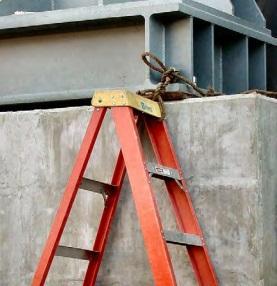In this article, I’ll be discussing the importance of ladder safety and, specifically, the best ways to tie off ladders to prevent accidents. While OSHA does not require portable ladders to be tied off, (see 30 CFR § 56/57.11004), it’s still a recommended good practice
In the last ten years, it has been reported that nearly half of all workplace fatalities resulting from a fall can be attributed to falls from ladders. By familiarizing yourself with ladder safety and learning how to securely place a ladder, the risks associated with ladders can be drastically minimized.
When tying off a ladder, there are two essential steps you should take: secure it from both the bottom and top. Two of the largest potential hazards when utilizing a ladder are due to its movement while in use. If it is not securely attached at the bottom, there is always an imminent risk that your feet could slip away from the wall quickly, and you would inevitably fall with it. Not only does this put you in danger of injury upon contact with the floor, but any tools or heavy materials will also crash down on top of you, which can cause further harm. Thankfully, there are ways to prevent such occurrences from happening!
- Tying off a ladder is a critical safety step when working at heights: By tying off a ladder, you help to ensure that the ladder remains stable and in place, and prevents it from sliding or shifting while in use. This is especially important when working on uneven or slippery surfaces. When a ladder is not tied off, it increases the risk of the ladder sliding or shifting, which can cause the person on the ladder to lose their balance and fall.
- One of the most effective ways to tie off a ladder is to use a ladder stabilizer: Ladder stabilizers are devices that attach to the ladder and extend out to the side, providing additional stability and preventing the ladder from sliding or shifting. They are easy to install and use and are widely available. By using a ladder stabilizer, you can ensure that the ladder remains stable and in place, even on uneven or slippery surfaces. It is important to select the appropriate ladder stabilizer for the type of ladder you are using and to install it correctly.
- Another effective way to tie off a ladder is to use ladder levelers: Ladder levelers are devices that are placed on the ladder legs and can be adjusted to level the ladder on uneven surfaces. This helps to prevent the ladder from sliding or shifting and keeps it in place. Ladder levelers are particularly useful when working on uneven surfaces, such as sloping or rocky terrain. It is important to select the appropriate ladder leveler for the type of ladder you are using and to adjust it correctly.
- Suppose a ladder stabilizer or ladder leveler is not available. In that case, it is also possible to tie off a ladder using rope or webbing: This can be done by attaching the rope or webbing to the ladder and then securing it to a stable anchor point. This helps to prevent the ladder from sliding or shifting and keeps it in place. It is essential to use a sturdy rope or webbing that can hold the weight of the ladder and person using it, and to tie it off to a stable anchor point.
- When using a ladder, it is also important to ensure that it is placed on a stable surface: Ladders should never be placed on loose or unstable surfaces, such as wet or icy ground, or on top of other objects. This can cause the ladder to slip or tip over, resulting in a fall. It is important to inspect the area where the ladder will be placed, to remove any obstacles and to make sure that the surface is stable and level.
- It is also important to ensure that the ladder is properly set up and that all of the locks and safety latches are securely in place: This helps to ensure that the ladder is stable and in place and that it will not slip or shift while in use. If a ladder is not properly set up, the locks and safety latches may not be able to keep the ladder in place, increasing the risk of a fall. It is important to read and follow the manufacturer’s instructions for setting up and using the ladder to ensure that it is being used correctly and safely.
- Another important safety tip is to use a ladder that is the right size for the job: Ladders that are too short or too long can cause stability issues and increase the risk of a fall. It is important to select a ladder that is appropriate for the task at hand and that is rated for the weight of the person using it. Before using a ladder, always check the weight rating and ensure that it is rated for the weight of the person using it.
In conclusion, ladder safety is crucial when working at heights. Tying off a ladder is one of the most effective ways to ensure that the ladder remains stable and in place, preventing accidents. By using ladder stabilizers, ladder levelers, or rope and webbing, placing the ladder on a stable surface, ensuring the ladder is properly set up, and using the appropriate ladder size, you can help to keep yourself and others safe while working at heights. It is important to always follow the manufacturer’s instructions and to conduct regular inspections of the ladder to ensure that it is in good working condition. Remember, ladder safety is the responsibility of everyone who uses a ladder, whether it’s for work or for personal use.










